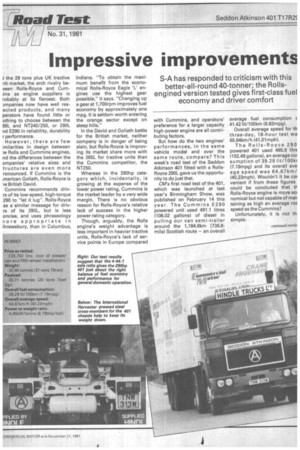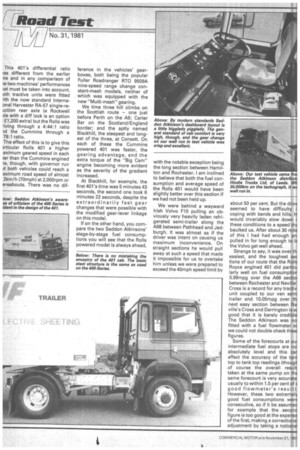Impressive improvements
Page 27

Page 28

Page 29

If you've noticed an error in this article please click here to report it so we can fix it.
S-A has responded to criticism with this better-all-round 40-tonner; the Rollsengined version tested gives first-class fuel economy and driver comfort
the 28 tons plus UK tractive nit market, the arch rivalry beveen Rolls-Royce and Cumtins as engine suppliers is robably at its fiercest. Both )mpanies now have well resected products, and many perators have found little or othing to choose between the 55L and NT240/250, or 290L nd E290 in reliability, durability r performance.
However, there are few imilarities in design between le Rolls and Cummins engines, nd the differences between the ompanies' relative sizes and tructures are even more ronounced. If Cummins is the merican Goliath, Rolls-Royce is le British David.
Cummins recommends drivrs of its low-speed, high-torque 290 to "let it lug". Rolls-Royce as a similar message for drivrs of its 290L, but is less oncise, and uses phraseology lore appropriate in lhrewsbury, than in Columbus, Indiana. "To obtain the maximum benefit from the economical Rolls-Royce Eagle 'L' engines use the highest gear possible," it says. "Changing up a gear at 1,700rpm improves fuel economy by approximately one mpg. It is seldom worth entering the orange sector except on steep hills."
In the David and Goliath battle for the British market, neither company is in danger of being slain, but Rolls-Royce is improving its market share more with the 265L for tractive units than the Cummins competitor, the NT250.
Whereas in the 290hp category which, incidentally, is growing at the expense of the lower power rating, Cummins is the market leader by a very wide margin. There is no obvious reason for Rolls-Royce's relative lack of success in the higher power rating category.
Though, arguably, the Rolls engine's weight advantage is less important in heavier tractive units, Rolls-Royce's lack of service points in Europe compared with Cummins, and operators' preference for a larger capacity high-power engine are all contributing factors.
But how do the two engines' performances, in the same vehicle model and over the same route, compare? This week's road test of the Seddon Atkinson 401 fitted with a RollsRoyce 290L gave us the opportunity to do just that.
CM's first road test of the 401, which was launched at last year's Birmingham Show, was published on February 14 this year. The Cummins E290 powered unit used 491.1 litres (108.02 gallons) of diesel in pulling our van semi-trailer around the 1,184.6km (736.8mile) Scottish route — an overall average fuel consumption c 41.42 lit/100km (5.82mpg).
Overall average speed for th three-day, 18-hour test wa 65.94km/h (41.01mph).
The Rolls-Royce 290 powered 401 used 465.9 litrE (102.49 gallons), an average cot sumption of 39.29 lit/100kr (7.19mpg) and its overall ave age speed was 64.67km/ (40.23mph). Wouldn't it be cot venient if from these figures could be concluded that if Rolls-Royce engine is more ecr nomical but not capable of mail taming as high an average roE speed as the Cummins?
Unfortunately, it is not th simple.
This 401's differential ratio ,as different from the earlier ne and in any comparison of le two machines' performances let must be taken into account. oth tractive units were fitted ith the now standard Interneonal Harvester RA-57 single-reuction rear axle (a Rockwell de with a diff lock is an option :'E1,200 extra) but the Rolls was -lying through a 4:44:1 ratio id the Cummins through a 78:1 ratio.
The effect of this is to give this uticular Rolls 401 a higher aximum geared speed in each ar than the Cummins engined le, though, with governor run it both vehicles could reach a aximum road speed of almost 2km/h (70mph) at 2,000rpm or ereabouts. There was no dif ference in the vehicles' gearboxes, both being the popular Fuller Roadranger RTO 9509A nine-speed range change constant-mesh models, neither of which was equipped with the new "Multi-mesh" gearing.
We time three hill climbs on the Scottish route — one just before Perth on the A9; Carter Bar on the Scotland/England border; and the aptly named Blackhill, the steepest and longest of the three, at Consett. On each of these the Cummins powered 401 was faster, the gearing advantage, and the extra torque of the "Big Cam" engine becoming more evident as the severity of the gradient increased.
At Blackhill, for example, the first 401's time was 5 minutes 43 seconds, the second one took 6 minutes 22 seconds, despite the extraordinarily fast gear changes that were possible with the modified gear-lever linkage on this model.
If on the other hand, you compare the two Seddon Atkinsons' stage-by-stage fuel consumptions you will see that the Rolls powered model is always ahead, with the notable exception being the long section between Hamilton and Rochester. I am inclined to believe that both the fuel consumption and average speed of the Rolls 401 would have been slightly better over this section if we had not been held up.
We were behind a wayward Irish Volvo F10 pulling an obviously very heavily laden refrigerated semi-trailer along the A68 between Pathhead and Jedburgh. It was almost as if the driver was intent on causing us maximum inconvenience. On straight sections he would pull away at such a speed that made it impossible for us to overtake him unless we were prepared to exceed the 40mph speed limit by about 50 per cent. But the drivE seemed to have difficulty i coping with bends and hills. H would invariably slow down i these conditions to a speed ths baulked us. After about 30 mile of this I had had enough an pulled in for long enough to IE the Volvo get well ahead.
Strange to say, it was over th easiest, and the toughest sec tions of our route that the Rolls Royce engined 401 did particu larly well on fuel consumptior 5.99mpg over the A68 sectio: between Rochester and Neville' Cross is a record for any tractiv, unit coupled to our van semi trailer and 10.05mpg over th, next easy section between Ne ville's Cross and Darrington is sc good that it is barely credible The Seddon Atkinson was no fitted with a fuel flowmeter sc we could not double check these figures.
Some of the forecourts at ou: intermediate fuel stops are no: absolutely level and this car affect the accuracy of the tanl, top to tank top readings (though of course the overall result taken at the same pump on thE same forecourt is very accurate usually to within 1.5 per cent of s good flowmeter's result) However, these two extremely good fuel consumptions werE consecutive, so if it be assume° for example that the second figure is too good at the expense of the first, making a correctional adjustment by taking a notional
lount of fuel from the first fill and adding it to the second puld make the A68 fuel conmotion figure better than )mpg, and even less credible.• Seddon Atkinson's specificain sheets show the Rolls}yce 290L engined sleeper cab 1 to be 150kg (331Ib} lighter an the same vehicle fitted with e Cummins E290 engine. So len our weighbridge check of e tractive unit weight in its unden, ready for the road condi}n, revealed it to be virtually e same weight as the Cumins 401 there was some insternation. MIRA's staff pollly, but very firmly, confirmed le accuracy of their eighbridge when, with all due spect, the question was asked. was only after the test, by foging through the old road test e, that I solved the mystery. The first 401 tested had had an iaccurate fuel gauge and .ither the SA representative )r I had noticed this until after e test weighing. What we ought was a kerb weight with full tank of fuel was in fact with imething less than that. I'll be 'likely to trust a fuel gauge Jain.
There is no question that the 30L is lighter than the E290. Its nailer capacity, 12.17 litres as 3ainst 14 litres, gives it a head art and the 'extensive use of Iuminium alloy on various Kte rn a I engine components alps. The engine's weight was irther reduced last year when le block and head castings 'ere generally tidied up.
The 290L cannot match the 290 for maximum torque, but, aradoxically, the Rolls engine is a way more driveable. It is }markably willing to pull at }ally low revs, way below the laximum torque speed of ,300rpm if you let it. There is no articular advantage in taking the engine speed down below 1,200rpm — the torque falls off below that speed and the specific fuel consumption curve rises — but this characteristic makes the Rolls engine very forgiving.
On a nasty little hill on the A68, for example, I was somewhat over optimistic in choosing 3rd gear (4th if you count crawler as first) as the one to take us over the summit. The engine speed fell more quickly than I had expected, showing that I had underestimated the steepness of the gradient; 1,200rpm was reached and the peak was still many yards away.
Rather than change down I decided to let the 290L flex its muscles. Without complaint the Rolls engine pulled all the way down to 900rpm — and took us over the summit without a downchange.
Summary Whichever engine is fitted to it, the 401 is an impressive tractive unit. In CM's original test of the newest SA we concluded that the particularly attractive features for many operators would be its light weight combined with a high standard of driver comfort and the way which the Oldham based man' facturer has responded t criticism positively, by makir numerous improvements °Nil the 400-Series. I thought that th only fly in the ointment might I the high price.
Since January, the 401's retz price has actually come dow Furthermore, the 2901_ powere version is some £400 less expe sive than the E290 version. As percentage of a vehicle's who life cost that is minute, but st not to be sniffed at.
The Rolls-Royce engine other main advantages are i light weight and first-class fu economy (but the gearing d ferences between the two testi 401s must be remembered).
In any discussion about ti 401 it should not be forgotti either that Gardner engines a offered also. It is difficult to u derstand why the Patricroft coy pany seems to be unwilling match its products against t opposition in road tests.
Certainly the performance the Rolls-Royce 290L over e Scottish test route does not E plain why this engine's marl share is so small.


















































